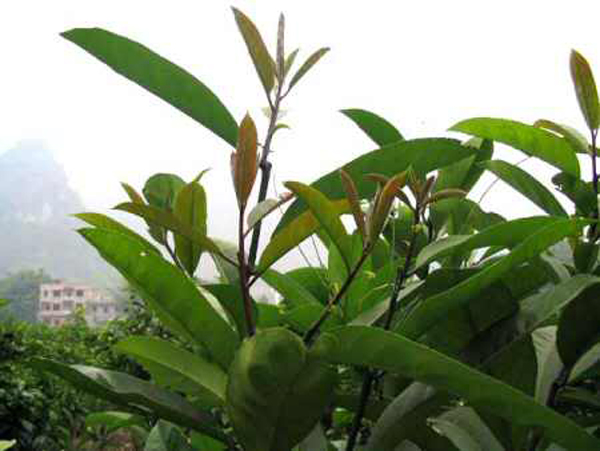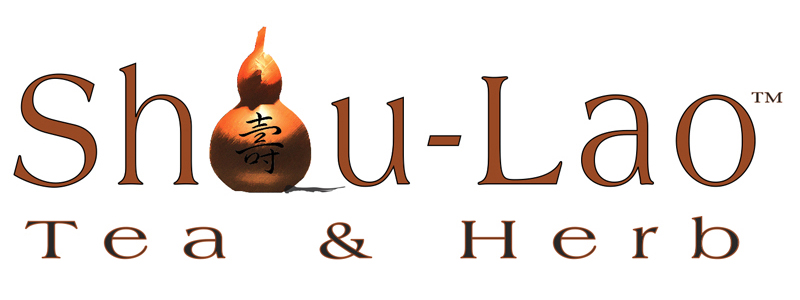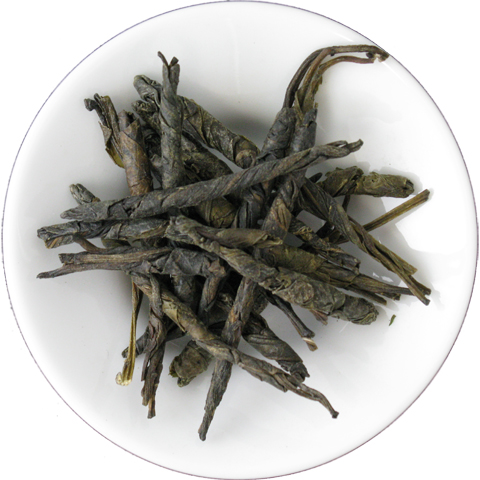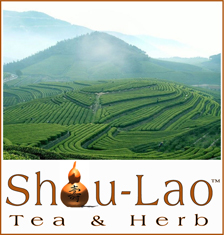Kuding Cha 苦子
Kuding tea, also known as "Bitter Tea," is a very unique Chinese tea. This variety uses a larger leaf, and is less processed therefore it lacks the uniformity in presentation that the "Royal" varieties offer, yet it is no less still a very good quality kuding regardless. It does not fall into any tea categories of Green, Black, Oolong or White tea, which are all made from the leaves of Camellia Sinensis. It does not even necessarily fall into the category of an Herbal Tisane either, yet at the same time it exhibits the qualities found within all of these categories, as well as exhibiting the qualities of an effective herbal medicinal. Kuding Tea itself is made from the leaves of the holly category of Ilex or Ligustrum. Kuding tea is made from the leaf of Broadleaf Holly which belongs to the Folium Llicis Latifoliae family. According to the entry in the Herbalist Doctor Glossary, Kuding tea has a bitter taste and has a cleansing effect. It cures Headache, aids Toothache, Pinkeye and Tinnitus. Medical research shows that Kuding tea contains many important and therapeutic bioactive chemicals such as: 22 Kuding Glycin, 1.4 Aminophenol, 8.8 polyphenols, 41 Vitamin C, 1.2 Flavonoids, etc. Kuding tea has been proven to be a highly valuable health drink that has therapeutic powers of cooling, cleansing, alexipharmic, antibacterial, lowering blood pressure, and improving digestion. These attributes of Kuding along with the presence of 41 Vitamin C, have recently led to more specific studies that are presently underway with regard to the use of Kuding in effectively addressing diabetic complications as it has been found that 41 Vitamin C beneficially influences the two mechanisms of diabetic complications; the glycation and the sorbitol pathway (Joe A. Vinson, Thomas B. Howard III). Yet another study in this regard is currently in underway which also looks quite promising, in examining the treatment of general diabetic complications utilizing the combination of Kuding Tea along with American Ginseng, yet another beneficial herb for diabetic patients.
In Chinese, "Ku" means bitter, describing the taste, and "Ding" means nail, or a small piece, indicating the shape of the tea leaves. Kuding tea has a very special type of bitter taste which people sometimes find hard to accept in their first encounter. However the more one drinks, the more one will be able to appreciate the sweet flavor accompanied by the bitterness. Kuding however is one of the most famous types of tea in Chinese history. According to Compendium of Materia Medica (Bencao Gangmu) compiled and written over the course of twenty-seven years by the famous physician Li Shizhen (1518-1593), the medicinal properties associated with Kuding Tea include its ability to disperse wind-heat, clear the head and the eyes, alleviate thirst, invigorate digestion, keep up the spirits, resolve toxin, and reduce inflammation as well as what is regarded today as its ability lower blood pressure and blood lipids. Kuding tea contains more than 200 elements including Kuding Saponins, Amino Acids, Vitamin C, Polyphenols, Flavonoids, Caffeine, Protein.
Kuding Tea is a traditional health drink, known for its many medicinal properties as stated above, it is additionally considered to be cooling, detoxifying, promoting blood circulation and aiding digestion. Kuding tea is appreciated more for its valuable medicinal properties than its taste, as it is a particularly bitter-tasting Chinese Tisane. However those individuals who enjoy taking coffee black, for instance, will not be at all deterred with this presentation to their palate. The traditional Chinese medicinal properties associated with Kuding include its ability to disperse wind-heat, clear the head and the eyes, and resolve toxin, thus it is used effectively for the common cold, for rhinitis, itching eyes, red eyes, and headache. It is also said to calm fidgets and alleviate thirst, especially when one is suffering from a disease that causes fever or severe diarrhea. It helps to resolve phlegm and damp conditions, and alleviates coughing, thus used in treating bronchitis. Finally, it is said to invigorate digestion and improve mental focus and memory. Modern research is presently suggesting that kuding promotes blood circulation, lowers blood pressure, and lowers blood lipids, including cholesterol. It has the reputation as an anti-inflammatory, and of preventing deterioration of the heart and brain function in addition to aiding in maintaining proper body weight.
Kuding tea can come in a few different forms, it can come as a loose leaf tea, in the shape of a nail, or in a ball shape. For the individual consuming one cup at a time, one piece of kuding tea is enough for one cup of brewing. Kuding tea has the reputation of "health tea," a "longevity tea," and a "slim tea," all in one cup. it has been proven that kuding tea can diminish inflammation and ease pain, enhance vigor, clean out toxins, reduce body fat, reduce blood pressure, and keep the body fit.
Note: Those who are of cooler disposition who become cold more easily, but who wish to consume Kuding Tea on a daily basis for its slimming properties, are advised to combine their consumption with a warming herb such as a good quality ginseng product so as to prevent the body from becoming cold. This is especially recommended in the winter months. An example of one traditional use can be seen in Sichuan Province, where the weather is quite yin, that is cool and damp, and residents have a tradition of consuming very spicy foods. Whereas cold and damp weather can easily become lodged within the body, it is expelled through the sudden sweat that the spicy cuisine induces, and as a balancing factor kuding tea is very commonly consumed after these spicy meals to balance any accumulation of excess heat that may lead to indigestion, acid reflux and the like. So in this sense, although in summer months when it can be quite warm and the consumption of kuding is a welcome cooling factor, in winter months one should bear in mind that daily consumption should be balanced either through ones diet by adding extra ginger or basil to meals, or it can be approached with a warming tonic herbal formula containing such herbs as ginseng, or astragalus.
Origin: Anhui, China
Harvest Period: 2010
Brewing Guide: Steep tea one or two spikes or pieces of Royal Kuding in hot water at 175F to 195F for 1 to 2 minutes for the first and second brewing. Gradually increase steeping time and temperature for subsequent brewing. Since this tea has a very concentrated taste, it is suggested to brew this tea with less tea leaves and more water.




